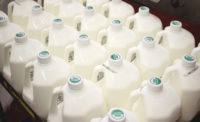Why eCommerce sales are expected to grow
Labor shortages expected to lead to more automation and changes in packaging for dairy products.

Photo courtesy of Tippapatt / iStock / Getty Images Plus.
Although eCommerce may not be for all dairy processors, it can definitely be an option for additional revenues. Gone are the days when consumers were hesitant about purchasing food and beverages on the internet, a move certainly facilitated by the COVID-19 pandemic.
In fact, Euromonitor International reported the number of Americans utilizing online grocery services skyrocketed from 13% before the pandemic to some 26% in 2022. According to several reports, the increase in smartphone usage is driving eCommerce sales higher.
Marketing Charts data is similar, stating some 28% of respondents in 2022 reported ordering groceries online for pickup or delivery at least once a month, up from 23% the prior year. The research firm adds that online grocery shopping is more common among higher-income than lower-income households: 37% of respondents with annual household income (HHI) of at least $100,000 reported doing so at least monthly, about twice the proportion of those with annual HHI of less than $40,000 (19%).
Food & Beverage (F&B) CPG (consumer packaged goods) eCommerce sales reached $75.1B in 2023, and in the latest 52 weeks ending Aug. 11, they’ve reached $80.1 billion, states Chicago-based market research firm Circana. This represents 9.2% and 9.6% of Total Omnichannel sales, respectively, up from 7.4% in 2021.
Circana data also reveals eCcommerce sales continue to grow year over, even as we move past the pandemic. “Consumers continue to flock to value and convenience, and the eCommerce value proposition delivers,” states Anne Zybowski, vice president of eCommerce for Chicago-based Circana. “Over 84% of shoppers are omnichannel shoppers and even if shoppers are not purchasing online, the eCommerce experience influences over 70% of sales.”

When specifically examining dairy, during the 52-week period ending Aug. 11, Circana has seen the greatest eCommerce growth in cottage cheese (+33%), whipped toppings-refrigerated (+26%) and creams/creamers (+23%). Meanwhile, slower eCommerce growth categories include margarine/spreads, up 8% and plant-based milk, up 1%. However, Circana notes the slower growth categories likely follow general industry trends and “ecommerce is not necessarily a barrier for these categories’ eCommerce opportunities.”

“Ecommerce already represents 10% of total omnichannel sales for these [dairy] categories; shoppers are purchasing them online,” Zybowksi suggests.
Is delivery too expensive?
For dairy processors, one of the most obvious eCommerce obstacles is delivery costs. Shipping a product that either requires refrigeration or being frozen can certainly be pricey. Hence, it is not for everyone.

The biggest hurdle to shipping ice cream is the most obvious one; “it has to be kept frozen until the consumer opens the cooler to put the ice cream in their freezer,” explains Richard Graeter, president and CEO of Cincinnati-based Graeter’s Ice Cream.
“Shipping perishable foods involves dry ice and next-day shipping, and when shipping outside the Midwest, this means expensive next-day-air shipping. Food safety is never a concern as dry ice — at 109 degrees below zero — keeps the ice cream frozen hard as a rock. We also guarantee shipments, so if the ice cream arrives melted, we ship out a replacement the next business day.”

Shipping anything next-day-air is expensive, Graeter stresses. “Adding special packaging costs for coolers and dry ice makes it the most expensive product you can ship pound for pound,” Graeter reveals.
Despite logistical challenges, Circana has seen eCommerce sales in the Frozen and Refrigerated segments increase by 30% and 34%, respectively, between 2021 and 2024. “Share of omni continues to grow. Refrigerated share has grown from 9.8 to 12.1 (2021-2024) and frozen share has grown from 7.4 to 9.3 (2021-2024),” Zybowksi reports.
Technology is certainly providing a boost for those seeking to get into eCommerce. “Warehouse automation offers a wide range of opportunities and benefits to CPGs and the third-party logistics companies (3PLs) many choose to carry out direct-to-consumer (D2C) fulfillment on their behalf,” Jorge Izquierdo, vice president of market development, PMMI, The Association for Packaging and Processing, tells Dairy Foods.
“Ecommerce is continuing to add complexity to distribution of goods, with increasing demand for mixed and layered pallets. CPGs are turning to warehouse automation solutions, such as palletizers and mobile robots.”
Izquierdo notes labor shortages are a major factor across the warehouse sector and is “both encouraging companies to invest in automation technology — as they can’t get product out of the warehouse fast enough — and deterring them from doing so because of a shortage of skilled labor to operate new machines. Companies investing in warehouse technology are reaping the rewards of doing so, in terms of greater efficiency, quality and productivity.”
In the future, Izquierdo expects the complexity and growth of eCommerce to “likely see larger companies establish their own D2C operations, employ warehouse and packaging automation technology to make them more efficient; while smaller CPGs are expected to continue relying on 3PLs and their facilities.”
It can be done
Although eCommerce can be complex, several dairy processors have navigated the waters successfully and have found it to be an excellent way to diversify their business. Ecommerce was a boon for Graeter’s business during the COVID-19 pandemic.
Although shipping is expensive, Graeter stresses selling ice cream online can be a truly memorable gift and worth the price. Also, although you can now find a “few flavors of Graeter’s in many other parts of the country, if you want your favorite flavor, a seasonal flavor, or any of our extremely limited-edition bonus flavors, you can only buy those online,” Graeter notes.
“A gift of Graeter’s Ice Cream is one of the most appreciated and memorable treats that you can send someone. Ecommerce is also an important channel for Graeter’s to reach customers beyond the Midwest. It diversifies our channels, the other two being our 56 brick-and-mortar retail stores and wholesale to grocery stores like Kroger,” relays Graeter,
Although eCommerce is Graeter’s smallest channel, “during COVID, our online sales doubled, showing the importance of diversifying sales channels. Our former facility could only process so many orders per day, and we have since moved to a new, expanded facility to remove the bottleneck,” Grater adds. “Now, we are eager to find new sales to fill our new expanded facility which can handle four times the volume of our former facility.”
Another positive for dairy processors seeking to enter eCommerce is basket size. Research suggests consumers spend more in online trips compared to visiting a physical location.
“Generally, baskets are bigger for online grocery purchases compared to in-store, and for many omnichannel shoppers, it is often a stock-up trip,” Zybowski reveals. “Online shopping sites remember your past purchases — online and in-store — and make them easily accessible to add to your basket via ‘Favorites’ or ‘Past Purchase Features’ that saves time shopping for what shoppers know they want and allows more time for browsing.”
What happens next?
Overall, eCommerce is likely to grow in the future due to consumer demand.
“Year-over-year, eCommerce continues to be the No. 1 driver of overall growth across all categories and many brands have work to do to ensure they are getting fair share of the category online as they expect in-store,” Zybowksi maintains. “It requires having the right omnichannel data sets to ensure you can track how ecommerce is growing, and which key drivers are most important to driving growth, as each retailer algorithm is different.”
Izquierdo expects D2C to be an added benefit of changes that are coming our way “whether we like it or not.”
He believes changes will be forced upon manufacturers, including dairy processors, because many will need to turn to automation as solution, “in part because the goalposts for return on investment has moved, with the cost of automation decreasing while labor costs skyrocketed,” Izquierdo states. “Relatively cheap micro-automation solutions mean adoption of automation technology is spreading and becoming viable for smaller CPG companies with lower budgets for automation and smaller throughputs.”
While conducting research for a PMMI report titled “Packaging and Automation in the Warehouses of the Future 2023,” the trade group interviewed several CPG companies. One company notes it sees micro fulfillment taking place along with automation driven by eCcommerce.
“As we continue to see that evolve at the customer end of the supply chain, I think we are going to get pressure internally to make their process more efficient,” the report states. “And full pallets of single product loads is inefficient for them. I think they’re going to want to see layers, they’re going to want to see individual cases to help them with a micro fulfillment perspective.
“So, I think over time, we’re going to see pressure to create more efficiency in a micro fulfillment space, that naturally drives mixed pallets and layered pallets internally,” the CPG company adds. “If we can do that to make micro fulfillment more efficient, then that gives us the capability to do more direct-to-consumer ourselves.”
No matter what the future brings, Graeter’s is enthusiastic about eCommerce. When asked if he believes eCommerce sales for Graeter’s Ice Cream will grow in the future, the company president and CEO responds, “Absolutely. I’m counting on it.”
Looking for a reprint of this article?
From high-res PDFs to custom plaques, order your copy today!






